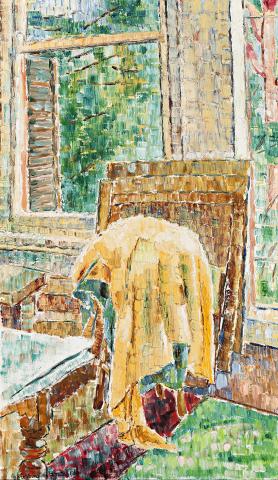DRAPERY IN THE STUDIO, 1960
GRACE COSSINGTON SMITH
oil on board
46.0 x 27.0 cm
signed and dated lower right: G Cossington Smith 1960
artist’s label verso inscribed with title
The Macquarie Galleries, Sydney
Private collection, Sydney, acquired from the above in 1964
Thence by descent
Private collection, Melbourne
Grace Cossington Smith, Macquarie Galleries, Sydney, 28 October – 9 November 1964, cat. 20
Paintings from artists’ collections and their families are always of special interest. Chosen with an eye for quality and individuality, they invariably stand out as highly characteristic and visually absorbing. So it is with Grace Cossington Smith’s Drapery in the Studio, 1960, which once belonged to Judith Murray, daughter of Roland Wakelin. Wakelin, like Cossington Smith, is long acknowledged for introducing Post-Impressionist and other modernist ideas into Australian art. Together, they were part of Sydney’s Contemporary Group established in 1926, exhibiting ‘advanced’ works over a number of years.
In Drapery in the Studio, what could be more commonplace a subject than some pieces of material hung over the edge of a chair? Yet, in this work and other like paintings of still life such as Golden Wattle Interior, c.1955 (Deutscher and Hackett, 2 December 2015, lot 23), Cossington Smith endows the everyday with that rare quality of colour and light that distinguishes it from and outshines those of others artists. Colour for Cossington Smith was what she described as her ‘chief interest … not the flat crude colour, it must be colour within colour, …, light must be in it’. 1 For her, colour and light have depth and meaning beyond the mere physical, taking on spiritual power and enlightenment. Yellow, in which they combine, was her favourite, found here not only in the drapery but also in the very light of the sun pouring through the large windows to drench the studio with its living-giving qualities. Compositionally it plays as central a role as it does metaphorically, seen in the related painting Yellow Drapes, 1954 (Deutscher and Hackett, 30 April 2014, Melbourne, lot 3). For Cossington Smith, yellow was ‘the colour of the sun’, ‘…harmonizing the commonplace with the metaphorical’.2
From enjoyment of the beauty of the visual world, her paintings lead to the contemplation of the spiritual therein, the wonder of life and the peace found in simplicity, perceived with such transforming insight. This marriage of profundity and simplicity continues in the actual paint itself. Engaging the technique of broken colour applied with the square-ended brush, the results are like mosaics both in their shape and brilliant reflection of light. These vibrant paint surfaces excite the eye as much as do the light and colour, creating an appealing harmony of happiness and joy. Still life painting plays a unique role in art; and Australian women artists such as Margaret Preston and Grace Cossington Smith, as this painting on offer so readily reveals, are among our finest.
1. Smith, G. C., in conversation with De Berg, H., 16 August 1965, National Library of Australia, Canberra, quoted in Modjeska, D., Stravinsky’s Lunch, Picador, Pan Macmillan Australia, Sydney, 1999, p. 227
2. Ibid, p. 225
DAVID THOMAS
